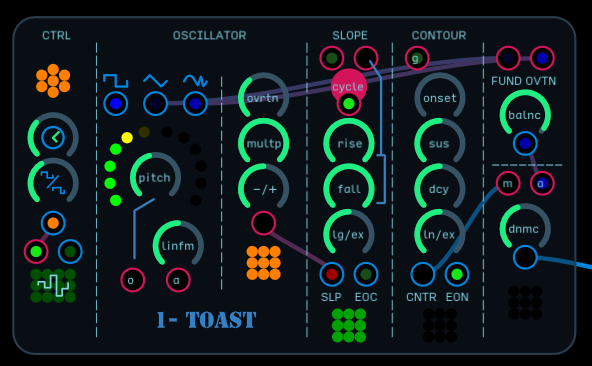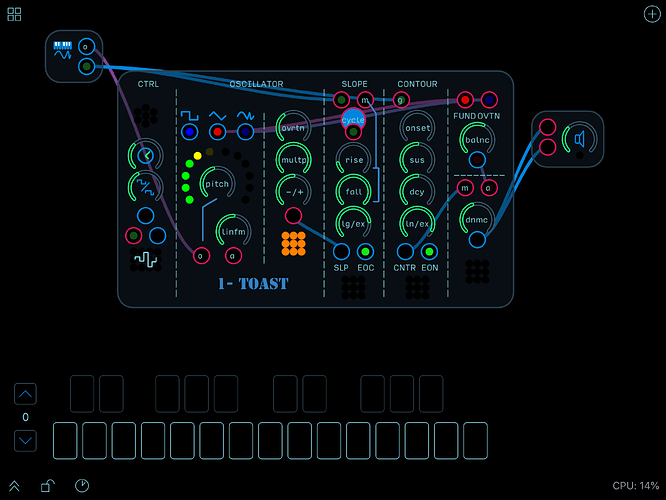
1-Toast
This is a single oscillator synth voice modeled after the 0-Coast from Makenoise. Unlike the 0-Coast, there is no normaling in Audulus so the basic patch in preconfigured in the download pack, or you can use the above image as a reference.
From left to right there is a clock with variable duty cycle and a random modulation generator which can be used to create stepped random modulations. There is an oscillator section with three outputs, triangle, square, and overtones. The oscillator also has a playable pitch knob (default tuning is knob setting .4414), ‘AC coupled’ linear FM, and a wave shaping/folding section modeled closely after the 0-Coast. The slope section is either an attack decay envelope or a variable slope LFO which is often used to modulate the multiply section of the overtones. The Contour section is a simplified ADSR with linear to exponential shaping. The last section is a two channel mixer, which is typically used to balance the triangle wave with the overtone wave, which runs into the dynamics section which is both a volume knob and a low pass gate, which usually receives modulation from the contour section.
I/O
| Input |
Signal Range |
Notes |
 |
1/oct |
main pitch control |
 |
0, 1 |
main gate input |
 |
0, 1 |
trigger input on random modulation generator and slope section |
 |
0, 1 |
unipolar modulation input for dynamics and slope sections |
 |
-1, 1 |
audio input for linear FM |
|
|
|
| Output |
Signal Range |
Notes |
 |
-1, 1 |
audio out |
 |
0, 1 |
clock out |
 |
0, 1 |
random modulation out and gate outputs for ‘end of cycle’ and ‘end of onset’ |
 |
0,1 |
modulation or envelope out |
Controls
| Knob |
Function |
Notes |
 |
clock rate |
|
 |
duty cycle |
|
 |
pitch |
default tuning is knob setting .4414 |
 |
overtone |
shapes the triangle wave in various ways that affect timbre |
 |
multiply |
more or less a wave folder |
 |
multiply modulation attenuverter |
incoming signals are scales positively or negatively and summed with the multiply knob position. |
 |
rise of slope |
|
 |
fall of slope |
|
 |
curve of slope |
adjusting the curve also adjusts the overall rate of the slope |
 |
attack of contour |
contour refers to an ADSR envelope with the nomenclature of Bob Moog |
 |
sustain level of contour |
|
 |
decay and release of contour |
|
 |
curve of contour |
|
 |
[crossfade of mixer inputs |
|
 |
index of dynamics section modulation |
|
| Button |
Function |
Notes |
 |
cycle toggle |
changed the slope section from an A-D envelope to an LFO |
Version History
| Revision |
File |
Date |
Notes |
| 1 |
0-Toast.audulus (190.8 KB) |
5/5/2018 |
Inspired by the Makenoise 0-Coast |
Demos
1 | 1-Toast Demo 5-5.audulus (860.8 KB) |5/5/2018 |
7 Likes
When I uploaded this to the forum, I made a ‘fun pack’ with the 1-Toast as well as chopped up versions of the sections that could be used as modules as well as a no-svg version of the default patch. I thought I would include it here… but I am through with taking screen caps of controls 
1-Toast Fun Pack.audulus (458.0 KB)
7 Likes
A blast from the past! (Well the recent past anyway  ) A definite classic in the making. This Audulus re-creation has much of what made the original so appealing. A non-traditional approach to sound generation, a useful collection of generators and modulators, and an appealing UI. What’s not to love! One of your better efforts (although not the only one by any means).
) A definite classic in the making. This Audulus re-creation has much of what made the original so appealing. A non-traditional approach to sound generation, a useful collection of generators and modulators, and an appealing UI. What’s not to love! One of your better efforts (although not the only one by any means).
2 Likes
My favorite Audulus synth voice! 
3 Likes
Thanks for creating this. After bazilion years working with East-coast style subtractive synths, this and Bimini Road’s livestream showing off Rasmus have me very interested in West Coast style synths. While I really enjoy 1-Toast, I recall seeing a comment by you somewhere that you have some thoughts about how it might be programmed differently to be closer to the 0-Coast in sound.
I hope you’ll think about releasing a patch that implements those techniques.
3 Likes
I think the major improvements will come when I can normalize the signal flow inside the 1-Toast, which I think will have to wait for Audulus 4. But thanks for the kind words 
2 Likes
Will those changes give 1-Toast more of the ‘in the face’ waveshaping that the 0-Toast has?
I have a question about the ‘compat’ 1-Toast Default’ module in the fun pack – the one on the bottom right. Does the slope have any impact when it isn’t cycling?
I am a total newb and it is taking me a while to get a hang of analyzing patches.
Thanks so much for your great creations.
1 Like
A little bit. The 0-Toast mixes the slope signal in with the oscillator past 2 O’Clock on the timbre knob. Also, in A4 I can use samples of the 0-Coast waveforms rather than approximations, which should enhance verisimilitude. The same goes for the non-linear response of the wavefolder.
That said, I did try to emulate the 0-Coast I have in my possession as best I could. Of course, as time goes on and my understanding continues to improve hopefully so too will my modules 
No, because that’s the default for the 0-Coast.
Thanks for taking the time to play with them 
2 Likes
Thanks for the clarifications. I need to study the 0-Coast manual and some of the posted patches to understand it better. I am new to the West Coast/O-Coast paradigm and appreciating the sounds that the architecture unleashes.
I’d love to hear some of the music people are making with these modules.
Audulus makes appearances at some level in most of the songs on this album.
6 Likes
@robertsyrett:
Is the Slope’s ‘m’ input, the same as what was called ‘Time’ in the earlier 0-Toast version?
In a video talk in which Tony Rolando shows of the 0-Coast, he mentions that multiply uses square waves at several different frequencies to introduce harmonics. Do you have a sense of what he means by that? In the demo that I heard, the effect of turning up multiply almost sounds like hard-sync.
Curious to know your thoughts. Thanks.
2 Likes
I will have to get back to on that one. I have loaned my 0-Coast out at the moment, so I can’t plug it in to check. One of the things I have come to love about makenoise products is that they have the quality control of a proper manufacturer, as you expect of a former Moog employee, but they have a lot of authorial modding, almost like a circuit bending quality, to the internal routing. They are also kind of koy about what things actually do. For example they have these ¡¡!! inputs on the new QPAS module that they explicitly do not explain, “to encourage creative patch exploration.”
So I think in part, directly reverse engineering the 0-Coast, might be kind of missing the point. So for the most part I am just using my ears and trying to make the sounds match and the interface feel the same. The actual mechanisms are my own invention.
That said, the more I learn, the more I would like to revise and improve the 1-Toast design and maybe try and make something more accurate and mor my own.
Thanks.
What about the other question? Is the ‘m’ input on 1-Toast as the earlier 0-Toast’s time input?
The thing that impresses me about the demos I have heard of the 0-Coast (and I gather that this is true of their other models – but I am super new to West Coast synthesis) is that it captures the musicality of Buchla’s designs without being a copycat.
Something that they share (at least from the demos of Buchlas and 0-Coast that I’ve heard) is an interesting balance of musicality and harshness as you drive the wavefolder. There is a really cool harmonic sweep as you crank them.
That is correct! I think “m” is to indicate that this parameter responds to unipolar modulation.
I bought Audulus to try out the 1-Toast. I downloaded it and opened it up in Audulus but
I can’t figure out how to trigger it.
Pressing the keyboard does nothing. How do I trigger it? Sorry, I’m a complete newbie.
1 Like
You will need to a midi input/output module. Also, you need to connect the output to a speaker module. Here is a simple setup to control it from a speaker.
3 Likes
Thank you so much! It works perfectly 
1 Like





















 ) A definite classic in the making. This Audulus re-creation has much of what made the original so appealing. A non-traditional approach to sound generation, a useful collection of generators and modulators, and an appealing UI. What’s not to love! One of your better efforts (although not the only one by any means).
) A definite classic in the making. This Audulus re-creation has much of what made the original so appealing. A non-traditional approach to sound generation, a useful collection of generators and modulators, and an appealing UI. What’s not to love! One of your better efforts (although not the only one by any means).




